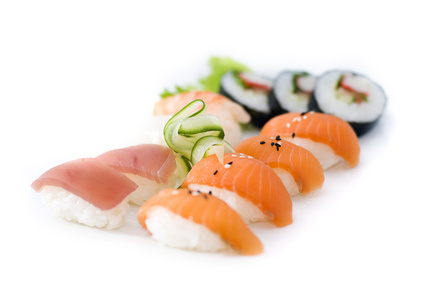Plate your portion:
Even if it’s only a snack or you’re all sharing tappas at the dinner table, dish up your helping every time you eat. This will help you tally up all you eat in a day, and will prevent you from overeating as you would if you were picking straight from a huge assortment of food options.
Look the part: Wearing something form-fitting is one of the easiest ways to make sure you don’t overindulge. Opt for clothes that are tight around the midsection and you’ll be more inclined to skip seconds.
Don’t leave the house hungry:
If you’re on your way to a festive function, snack healthily beforehand. Arriving hungry to an indulgent dinner often means over-dishing and over-eating. Curbing a ravenous appetite beforehand with a piece of fruit or some raw nuts means a more rational approach to the dinner table.
Stock up on protein:
Even if it hasn’t been prepared in the healthiest way, upping your usual ratio of protein to carbs at the dinner table means fewer calories and cravings overall. Meat proteins in particular take the body longer to digest, meaning you’ll eat less and be fuller for longer.
Halve your plate:
If you don’t feel like healthifying your pizza or swapping your pasta from creamy to tomato base, simply halve your portion. Cutting your meal in two immediately and serving the adjusted portion with a side of roasted veggies and salad is a great way to enjoy your favourite meal without overloading on calories. As a general rule, your plate should be 50% veggies/salad, 20% carbs and 30% protein.
Don’t drink your calories:
No matter how disciplined your eating, drinking your calories will undo your hard work. Cocktails are a huge caloric expense, and normal alcoholic drinks range from between 110-220 calories a pop. If alcohol is a must at dinner time, factor it into your eating plan. Treat each unit as one carb allocation, and restrict your carbs both on the day and after the event for a more balanced intake.
This goes for non-alcoholic drinks too! Soft drinks, iced teas and fizzy fruit juices are packed with non-nutritive calories. As a general rule, if it’s not alcoholic – stick to water.
General tips for healthier dining choices:
-
Skip the extras: there’s no need for bread or starters if you’re ordering a main meal. If starters are a must, order a starter for your main as well – chances are you’ll already be fuller than you realize. Two starters as a main is a great option in general, as the portions are usually significantly smaller and aren’t carb-heavy.
-
Get fussy: restaurants are becoming more and more sensitive to specialized orders. Ask if you can swap the starch for veggies, ask for the dressing on the side, and ask to take the cheese or basting off your burger.
-
Great options:
Mexican: Mexican meals can be packed with beans and legumes, tomato salsa and guacamole. Skip the sour cream and the grated cheese and your meal could have some real nutritional value. -
Tappas: Moroccan-style tappas can be great health-wise, as you can pick and choose every aspect of your meal. Opt for the high-protein and veggie options, and limit sides of rice or bread.
Lisa Raleigh
Lifestyle and Wellness Expert
www.lisaraleigh.co.za
facebook.com/LisaRaleighSA – Facebook
@LisaRaleighSA – Twitter
Proudly brought to you by @futurelifeZA
 a
a







@LisaRaleigh On How To Eat Healthier at Restaurants: http://t.co/tJnCAQPENa @futurelifeZA
New post: @LisaRaleigh On How To Eat Healthier at Restaurants: http://t.co/923NXzFgCm @futurelifeZA